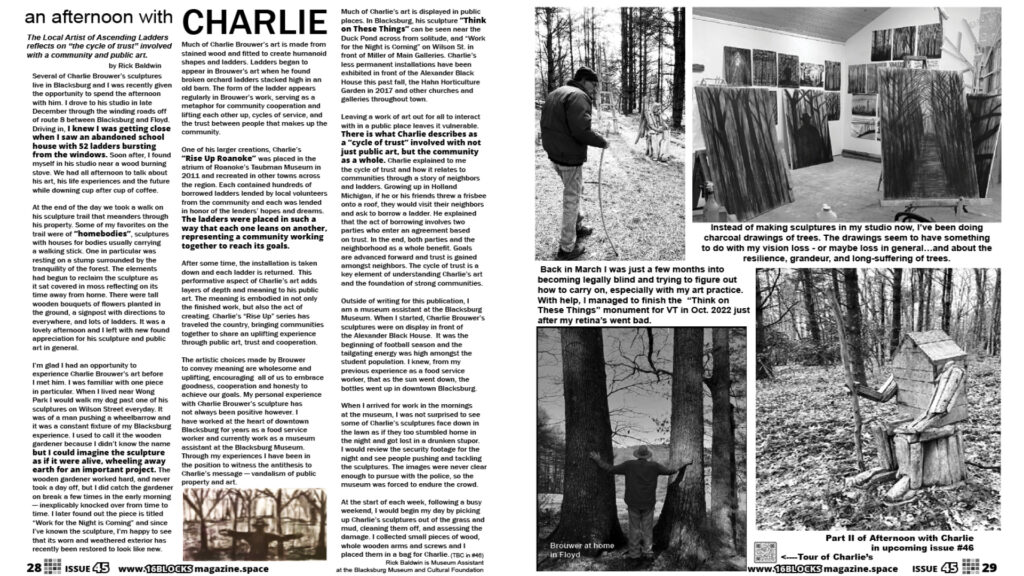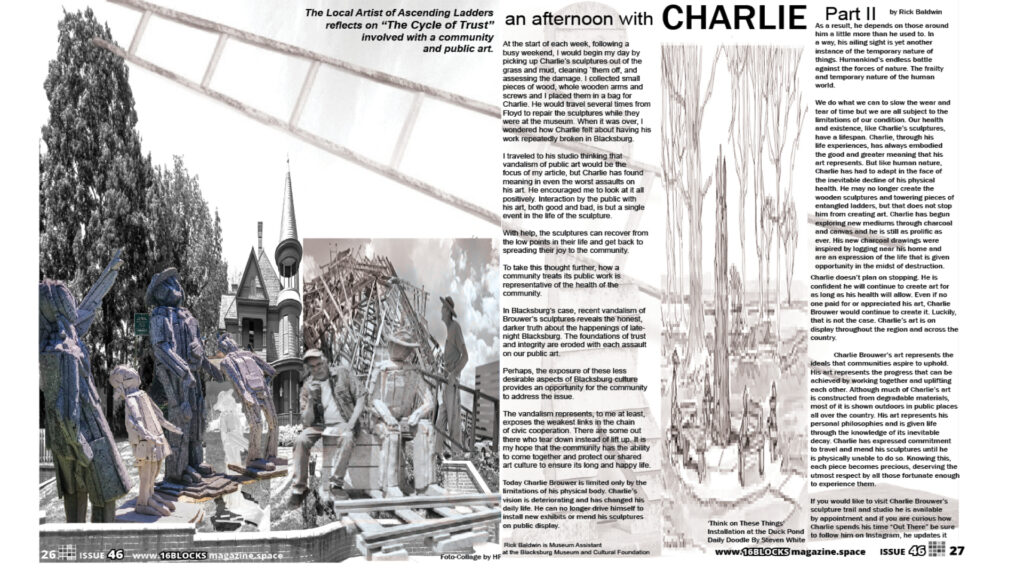The Local Artist of Ascending Ladders reflects on “the cycle of trust” involved with a community and public art after the vandalism of his Sculptures at Alexander Black House.
[THIS FIRST APPEARED IN PRINT #45 AND #46 IN IN WINTER 2023-24]

Several of Charlie Brouwer’s sculptures live in Blacksburg and I was recently given the opportunity to spend the afternoon with him. I drove to his studio in late December through the winding roads off of route 8 between Blacksburg and Floyd. Driving in, I knew I was getting close when I saw an abandoned school house with 52 ladders bursting from the windows. Soon after, I found myself in his studio near a wood burning stove. We had all afternoon to talk about his art, his life experiences and the future while downing cup after cup of coffee.
At the end of the day we took a walk on his sculpture trail that meanders through his property. Some of my favorites on the trail were of “homebodies”, sculptures with houses for bodies usually carrying a walking stick. One in particular was resting on a stump surrounded by the tranquility of the forest. The elements had begun to reclaim the sculpture as it sat covered in moss reflecting on its time away from home. There were tall wooden bouquets of flowers planted in the ground, a signpost with directions to everywhere, and lots of ladders. It was a lovely afternoon and I left with new found appreciation for his sculpture and public art in general.
I’m glad I had an opportunity to experience Charlie Brouwer’s art before I met him. I was familiar with one piece in particular. When I lived near Wong Park I would walk my dog past one of his sculptures on Wilson Street everyday. It was of a man pushing a wheelbarrow and it was a constant fixture of my Blacksburg experience. I used to call it the wooden gardener because I didn’t know the name but I could imagine the sculpture as if it were alive, wheeling away earth for an important project. The wooden gardener worked hard, and never took a day off, but I did catch the gardener on break a few times in the early morning — inexplicably knocked over from time to time. I later found out the piece is titled “Work for the Night is Coming” and since I’ve known the sculpture, I’m happy to see that its worn and weathered exterior has recently been restored to look like new.
Much of Charlie Brouwer’s art is made from stained wood and fitted to create humanoid shapes and ladders. Ladders began to appear in Brouwer’s art when he found broken orchard ladders stacked high in an old barn. The form of the ladder appears regularly in Brouwer’s work, serving as a metaphor for community cooperation and lifting each other up, cycles of service, and the trust between people that makes up the community.
One of his larger creations, Charlie’s “Rise Up Roanoke” was placed in the atrium of Roanoke’s Taubman Museum in 2011 and recreated in other towns across the region. Each contained hundreds of borrowed ladders lended by local volunteers from the community and each was lended in honor of the lenders’ hopes and dreams. The ladders were placed in such a way that each one leans on another, representing a community working together to reach its goals.
After some time, the installation is taken down and each ladder is returned. This performative aspect of Charlie’s art adds layers of depth and meaning to his public art. The meaning is embodied in not only the finished work, but also the act of creating. Charlie’s “Rise Up” series has traveled the country, bringing communities together to share an uplifting experience through public art, trust and cooperation.
The artistic choices made by Brouwer to convey meaning are wholesome and uplifting, encouraging all of us to embrace goodness, cooperation and honesty to achieve our goals. My personal experience with Charlie Brouwer’s sculpture has not always been positive however. I have worked at the heart of downtown Blacksburg for years as a food service worker and currently work as a museum assistant at the Blacksburg Museum. Through my experiences I have been in the position to witness the antithesis to Charlie’s message — vandalism of public property and art.
Much of Charlie’s art is displayed in public places. In Blacksburg, his sculpture “Think on These Things” can be seen near the Duck Pond across from solitude, and “Work for the Night is Coming” on Wilson St. in front of Miller of Main Galleries. Charlie’s less permanent installations have been exhibited in front of the Alexander Black House this past fall, the Hahn Horticulture Garden in 2017 and other churches and galleries throughout town.
Leaving a work of art out for all to interact with in a public place leaves it vulnerable. There is what Charlie describes as a “cycle of trust” involved with not just public art, but the community as a whole. Charlie explained to me the cycle of trust and how it relates to communities through a story of neighbors and ladders. Growing up in Holland Michigan, if he or his friends threw a frisbee onto a roof, they would visit their neighbors and ask to borrow a ladder. He explained that the act of borrowing involves two parties who enter an agreement based on trust. In the end, both parties and the neighborhood as a whole benefit. Goals are advanced forward and trust is gained amongst neighbors. The cycle of trust is a key element of understanding Charlie’s art and the foundation of strong communities.
Outside of writing for this publication, I am a museum assistant at the Blacksburg Museum. When I started, Charlie Brouwer’s sculptures were on display in front of the Alexander Black House. It was the beginning of football season and the tailgating energy was high amongst the student population. I knew, from my previous experience as a food service worker, that as the sun went down, the bottles went up in downtown Blacksburg.
When I arrived for work in the mornings at the museum, I was not surprised to see some of Charlie’s sculptures face down in the lawn as if they too stumbled home in the night and got lost in a drunken stupor. I would review the security footage for the night and see people pushing and tackling the sculptures. The images were never clear enough to pursue with the police, so the museum was forced to endure the crowd.
At the start of each week, following a busy weekend, I would begin my day by picking up Charlie’s sculptures out of the grass and mud, cleaning them off, and assessing the damage. I collected small pieces of wood, whole wooden arms and screws and I placed them in a bag for Charlie.

Part II
At the start of each week, following a busy weekend, I would begin my day by picking up Charlie’s sculptures out of the grass and mud, cleaning `them off, and assessing the damage. I collected small pieces of wood, whole wooden arms and screws and I placed them in a bag for Charlie. He would travel several times from Floyd to repair the sculptures while they were at the museum. When it was over, I wondered how Charlie felt about having his work repeatedly broken in Blacksburg.
I traveled to his studio thinking that vandalism of public art would be the focus of my article, but Charlie has found meaning in even the worst assaults on his art. He encouraged me to look at it all positively. Interaction by the public with his art, both good and bad, is but a single event in the life of the sculpture.
With help, the sculptures can recover from the low points in their life and get back to spreading their joy to the community.
To take this thought further, how a community treats its public work is representative of the health of the community.
In Blacksburg’s case, recent vandalism of Brouwer’s sculptures reveals the honest, darker truth about the happenings of late-night Blacksburg. The foundations of trust and integrity are eroded with each assault on our public art.
Perhaps, the exposure of these less desirable aspects of Blacksburg culture provides an opportunity for the community to address the issue.
The vandalism represents, to me at least, exposes the weakest links in the chain of civic cooperation. There are some out there who tear down instead of lift up. It is my hope that the community has the ability to come together and protect our shared art culture to ensure its long and happy life.
Today Charlie Brouwer is limited only by the limitations of his physical body. Charlie’s vision is deteriorating and has changed his daily life. He can no longer drive himself to install new exhibits or mend his sculptures on public display. As a result, he depends on those around him a little more than he used to. In a way, his ailing sight is yet another instance of the temporary nature of things. Humankind’s endless battle against the forces of nature. The frailty and temporary nature of the human world. We do what we can to slow the wear and tear of time but we are all subject to the limitations of our condition. Our health and existence, like Charlie’s sculptures, have a lifespan. Charlie, through his life experiences, has always embodied the good and greater meaning that his art represents. But like human nature, Charlie has had to adapt in the face of the inevitable decline of his physical health. He may no longer create the wooden sculptures and towering pieces of entangled ladders, but that does not stop him from creating art. Charlie has begun exploring new mediums through charcoal and canvas and he is still as prolific as ever. His new charcoal drawings were inspired by logging near his home and are an expression of the life that is given opportunity in the midst of destruction.
Charlie doesn’t plan on stopping. He is confident he will continue to create art for as long as his health will allow. Even if no one paid for or appreciated his art, Charlie Brouwer would continue to create it. Luckily, that is not the case. Charlie’s art is on display throughout the region and across the country.
Charlie Brouwer’s art represents the ideals that communities aspire to uphold. His art represents the progress that can be achieved by working together and uplifting each other. Although much of Charlie’s art is constructed from degradable materials, most of it is shown outdoors in public places all over the country. His art represents his personal philosophies and is given life through the knowledge of its inevitable decay. Charlie has expressed commitment to travel and mend his sculptures until he is physically unable to do so. Knowing this, each piece becomes precious, deserving the utmost respect by all those fortunate enough to experience them. If you would like to visit Charlie Brouwer’s sculpture trail and studio he is available by appointment and if you are curious how Charlie spends his time “Out There” be sure to follow him on Instagram, he updates it regularly.
